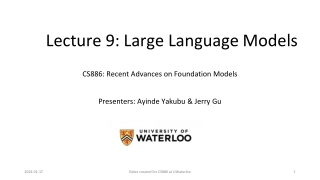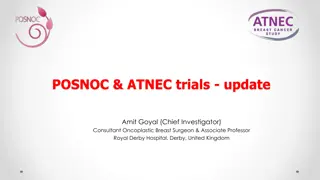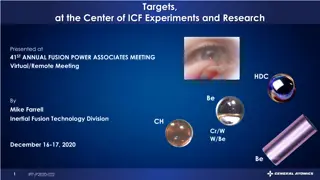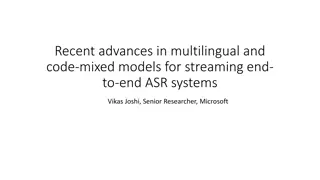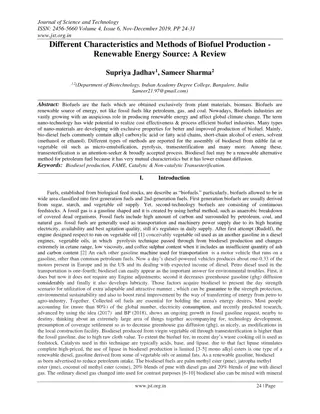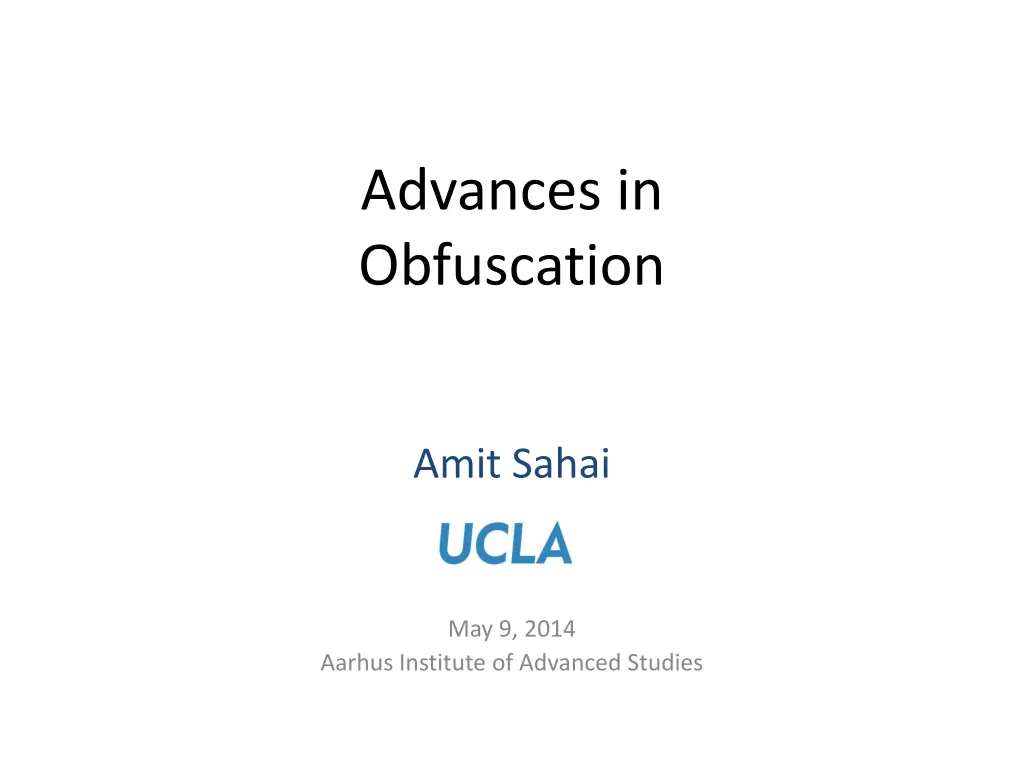
Advancements in Obfuscation Techniques and Security Measures
Explore the evolution of obfuscation methods, from ad-hoc to rigorous approaches, highlighting advancements in the field and the challenges faced. Delve into the concept of Indistinguishability Obfuscation (iO) and the quest for greater confidence in using black-box obfuscation for improved security.
Download Presentation

Please find below an Image/Link to download the presentation.
The content on the website is provided AS IS for your information and personal use only. It may not be sold, licensed, or shared on other websites without obtaining consent from the author. If you encounter any issues during the download, it is possible that the publisher has removed the file from their server.
You are allowed to download the files provided on this website for personal or commercial use, subject to the condition that they are used lawfully. All files are the property of their respective owners.
The content on the website is provided AS IS for your information and personal use only. It may not be sold, licensed, or shared on other websites without obtaining consent from the author.
E N D
Presentation Transcript
Advances in Obfuscation Amit Sahai May 9, 2014 Aarhus Institute of Advanced Studies
General-Purpose Obfuscation For decades: only ad-hoc methods, all broken This changed with [Garg-Gentry-Halevi-Raykova-Sahai-Waters, FOCS 2013]: First rigorous general approach Has led to many follow-up works already [everyone et al, 2013 & 2014]
Wait... What about [Barak-Goldreich-Impagliazzo-Rudich-Sahai-Vadhan-Ye 2001]? O(P) = P Isn t general-purpose obfuscation supposed to be impossible? What [BGIRSVY 2001] shows: There are contrived self-eating programs for which black-box obfuscation suffers from explicit attacks. What [BGIRSVY 2001] + follow-ups do not show: All programs cannot be obfuscated There is a natural setting where black-box obfuscation fails The [BGIRSVY 2001] lesson: Which secrets are hidden by obfuscation is not always clear.
How to Proceed Theoretically safest way forward: Indistinguishability Obfuscation (iO) Given two equivalent circuits (C0, C1), bounded adversary cannot distinguish (C0, C1, iO( C0 )) from (C0, C1, iO( C1 )) No impossibilities known: Definition does not tell us what secrets are (directly) hidden Still remarkably useful [ GGHRSW, Sahai-Waters 13, Garg-Gentry-Halevi-Raykova 13, (see Eurocrypt+ePrint) ] Also proceed anyway with black-box obfuscation Black-box obfuscation like random-oracle model ROM also has contrived negative results, but still very useful (e.g. IBE [Boneh-Franklin] G del Prize) Can we get more confidence in using black-box obfuscation, for instance with respect to idealized adversary model?
This talk: security of obfuscation How confident are we about obfuscation? Where does security really come from? This talk: Generic algebraic model security: [Barak-Garg-Kalai-Paneth-Sahai 13, Eurocrypt 2014]: black-box In this talk: quick overview, to set up for next result: Goldwasser-Micali style reduction security: [Gentry-Lewko-Sahai-Waters 14]: iO from Multilinear Subgroup Elimination Assumption. First assumption where challenge does not contain iO constructions. Recall: Assuming LWE, only need obfuscation for branching programs (in fact NC1)[GGHRSW 13].
Part I Generic Security For Obfuscation Previous work: [GGHRSW 13, Brakerski-Rothblum 13]: more restricted adversary, or strong complexity assumption
k Mmaps [Boneh-Silverberg 03, Garg-Gentry-Halevi 13] k levels of encodings: G1, , Gk: Each Gi is a copy of ZN. Maps: Addition: Gi x Gi to Gi Multiplication: Gi x Gj to G(i+j), if i+j k Zero-Test: Gk to {Yes,No} Generic k-mmap model: Algebraic framework implemented by oracles. Adversary never sees actual representations in Gi
Matrix Branching Programs [Barrington 86, Kilian 88, GGHRSW] Oblivious Matrix Branching Program for F: n bit input x (e.g. n=3 here) 2k matrices over ZN Evaluation on x: M1, 1 ~ M1, 0 ~ ~ M2, 0 ~ M2, 1 I if F(x)=0 B if F(x)=1 M3, 1 ~ M3, 0 ~ = Mi,x(i mod n) i=1...k ~ ~ M4, 0 M4, 1 Where B is fixed matrix I over ZN Kilian Randomization: Chose R1, , Rk-1 random over ZN Mk, 1 ~ Mk, 0 ~ Kilian shows that for each x, can statistically simulate Mx matrices knowing only product. ~
Obfuscation Construction Ideas [GGHRSW 13, BGKPS 13] Encode each matrix at level 1 using mmap: matrix multiplication is multilinear M1, 1 ~ M1, 0 ~ I if F(x)=0 B if F(x)=1 = Mi,x(i mod n) ~ M2, 0 ~ M2, 1 i=1...k M3, 1 ~ M3, 0 ~ Problems remain. Key Problem: Input-Mixing Attack Adversary may learn secrets in this case. We must prevent this. We do so by introducing straddling sets algebraic tool for preventing Input-Mixing (& more). ~ ~ M4, 0 M4, 1 Mk, 1 ~ Mk, 0 ~
Generic Black-Box Proof (a glimpse) Straddling sets allow decomposition of Adv queries into queries that only depend on matrices corresponding to single input. M1, 1 ~ M1, 0 ~ ~ M2, 0 ~ M2, 1 Heart of Proof: Query for single input can be statistically simulated [Kilian]. M3, 1 ~ M3, 0 ~ ~ ~ M4, 0 M4, 1 (many steps omitted) This gives us unconditional proof of black-box security in generic model. Mk, 1 ~ Mk, 0 ~
Part II Using reductions to argue security for iO. Goldwasser-Micali viewpoint (slightly different from yesterday s talk): Goal: Base security on assumption that does not directly provide obfuscated programs to Adversary.
Our Assumption [GLW14]: Multilinear Subgroup Elimination k-Mmap over composite N, with many large prime factors: One special prime factor c k distinguished prime factors a1, a2, , ak poly other primes Adversary gets Level-1 encodings: (random) generators of each prime subgroup, except c hi : random element of order c(a1a2 ai-1ai+1 ak) Adversary to distinguish between Level-1 encoding of: Random element T of order (a1a2 ak) Random element T of order c(a1a2 ak) Note: Assumption does not incorporate branching program matrices, straddling sets, circuits In fact, assumption made by [GLW14] in context without these.
Previous iO Assumptions Ad-hoc assumption, directly incorporating obfuscated programs: [GGHRSW 13, Pass-Seth-Telang (April 30, 2014 revision)] Mmap Meta-Assumptions [BGKPS 13] A Meta assumption is Assumption on Assumptions : E.g. All assumptions that satisfy X, Y, Z are true [PST 13]: iO from Meta-assumption based on generic security However, actual invocation of Meta-Assumption must directly incorporate obfuscated programs (into z,m0,m1) into Adversary s challenge given by assumption. Unsatisfying state of affairs from Goldwasser-Micali standpoint. Can we do better?
Is 2n security loss inherent? A good reason why we were stuck [Garg-Gentry-Sahai-Waters 13] for getting better assumptions. Informal Claim: all natural reductions have to confirm if C0 and C1 really are equivalent programs. (This takes 2n time, where n=input length.) Informal Proof Sketch: Suppose not, i.e., the reduction is only poly-time, and can t figure out if C0 and C1 are equivalent.
Is 2n security loss inherent? Consider Cb(x): Constant: y* If PRG(x)=y*, then output b; else output 0 Note: if y*chosen at random, then C0 and C1 are equivalent w.h.p., otherwise if y* = PRG(x*), they are not. Create attacker Atk for assumption A: Atk gets challenge ch from A. Choose y*=PRG(x*), create C0 and C1. Now Atk runs reduction on inputs ch, C0 and C1. Reduction makes oracle queries to a distinguisher between iO(C0) and iO(C1) But Atk can trivially distinguish P=iO(C0) vs P=iO(C1) by just running P(x*) Eventually, reduction breaks assumption A. Thus, if reduction cannot check equivalent of C0 and C1, then assumption A can be broken in poly-time. Complexity leveraging seems essential.
How to argue security Consider any hybrid argument from iO(C0) to iO(C1) There must be some critical hybrid step, where some actual computation switches from C0-like to C1-like. All previous work dealt with such a hybrid by directly invoking assumption very unsatisfying. How can we avoid this? Idea: Again use Kilian ssimulation to switch between C0 and C1for a single input. Can we use this idea within a reduction?
Overall reduction strategy We know reduction should take 2n time. Let s use this time to isolate each input, and somehow apply Kilian. Main idea: Have poly many parallel obfuscations, each responsible for a bucket of inputs Hybrid Type 1: Transfer inputs between different buckets, but programs do not change at all. Assumption used here. Hybrid Type 2: When one bucket only has a single isolated input, then apply Kilian and change the program. Information-theoretic / No Assumption needed.
Hybrids intuition C0 M1, 1 ~ M1, 0 ~ ~ M2, 0 ~ M2, 1 M3, 1 ~ M3, 0 ~ ~ ~ M4, 0 M4, 1 Mk, 1 ~ Mk, 0 ~
Hybrids intuition C0 C0 M1, 1 ~ M1, 1 ~ M1, 0 ~ M1, 0 ~ ~ ~ M2, 0 ~ M2, 0 ~ M2, 1 M2, 1 M3, 1 ~ M3, 1 ~ M3, 0 ~ M3, 0 ~ ~ ~ ~ ~ M4, 0 M4, 1 M4, 0 M4, 1 Mk, 1 ~ Mk, 1 ~ Mk, 0 ~ Mk, 0 ~
Hybrids intuition C0 C0 C0 M1, 1 ~ M1, 1 ~ M1, 0 ~ ~ ~ M2, 0 ~ M2, 0 ~ M2, 0 ~ M2, 1 M2, 1 M3, 1 ~ M3, 1 ~ M3, 0 ~ M3, 0 ~ M3, 0 ~ ~ ~ ~ ~ ~ M4, 1 M4, 0 M4, 1 M4, 0 M4, 1 Mk, 1 ~ Mk, 1 ~ Mk, 0 ~ Mk, 0 ~ Mk, 0 ~
All R matrices are independent per column. Can now use Kilian ! Hybrids intuition C0 C1 C0 M1, 1 ~ M1, 1 ~ M1, 0 ~ ~ ~ M2, 0 ~ M2, 0 ~ M2, 0 ~ M2, 1 M2, 1 M3, 1 ~ M3, 1 ~ M3, 0 ~ M3, 0 ~ M3, 0 ~ ~ ~ ~ ~ ~ M4, 1 M4, 0 M4, 1 M4, 0 M4, 1 Mk, 1 ~ Mk, 1 ~ Mk, 0 ~ Mk, 0 ~ Mk, 0 ~
Hybrids intuition C1 M1, 1 ~ M1, 0 ~ ~ M2, 0 ~ M2, 1 M3, 1 ~ M3, 0 ~ ~ ~ M4, 0 M4, 1 Mk, 1 ~ Mk, 0 ~
How to transfer inputs C0 C0 M1, 1 ~ M1, 1 ~ M1, 0 ~ M1, 0 ~ ~ ~ M2, 0 ~ M2, 0 ~ M2, 1 M2, 1 M3, 1 ~ M3, 1 ~ M3, 0 ~ M3, 0 ~ ~ ~ ~ ~ M4, 0 M4, 1 M4, 0 M4, 1 Mk, 1 ~ Mk, 1 ~ Mk, 0 ~ Mk, 0 ~
Our Assumption: Multilinear Subgroup Elimination k-Mmap over composite N, with many prime factors: One special prime factor c k distinguished prime factors a1, a2, , ak poly other primes Adversary gets Level-1 encodings: (random) generators of each prime subgroup, except c hi : random element of order c(a1a2 ai-1ai+1 ak) Adversary to distinguish between Level-1 encoding of: Random element T of order (a1a2 ak) Random element T of order c(a1a2 ak) Note: Assumption does not incorporate matrices, branching programs, straddling sets, circuits
How to transfer inputs (cheating) Prime a1 Prime c C0 C0 Use T to create these M1, 1 ~ M1, 1 ~ M1, 0 ~ M1, 0 ~ Use hi,i 1 to create rest (since they are the same in c and a1 subgroups) ~ ~ M2, 0 ~ M2, 0 ~ M2, 1 M2, 1 M3, 1 ~ M3, 1 ~ M3, 0 ~ M3, 0 ~ Missing ai in hi used to enforce input consistency. ~ ~ ~ ~ M4, 0 M4, 1 M4, 0 M4, 1 Key point: The programs for each prime is fixed. The reduction can directly build all matrices. Assumption plays no role in matrix choices. Mk, 1 ~ Mk, 1 ~ Mk, 0 ~ Mk, 0 ~
Conclusions Obfuscation: beautiful area for study These results: deeper understanding of where security can come from My take: Much less likely now that there might be a [BGIRSVY]-style negative result hiding in the iO woodwork Still an enormous amount of work to be done Security from LWE ? (Need mmap functionalities) Completely different obfuscation methods? Avoid mmap-like functionality altogether? Greater efficiency? Initial work: [Ananth-Gupta-Ishai-Sahai 14] Thank you



